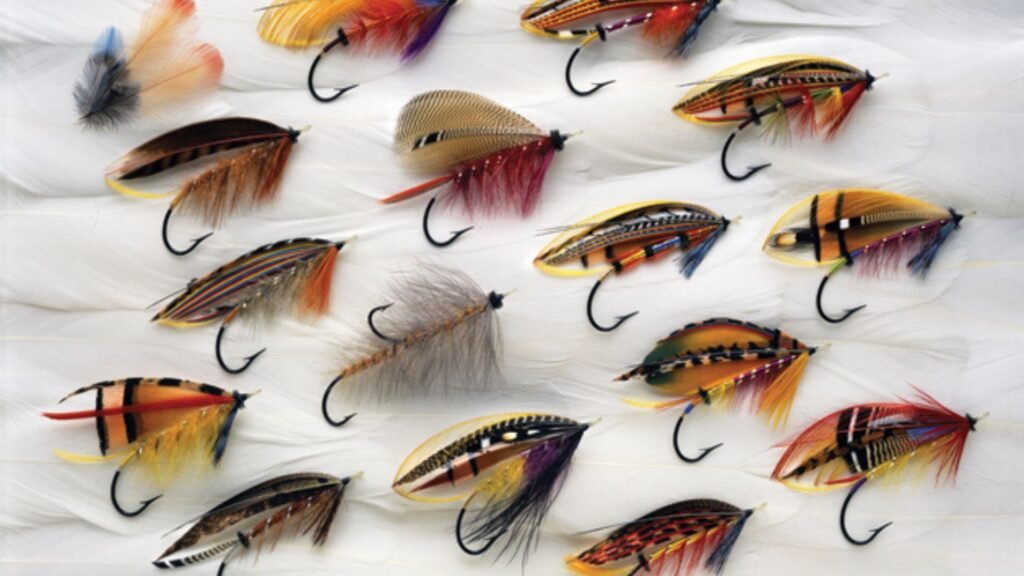Salmon flies have evolved significantly over the years. From traditional patterns to modern innovations, these flies have transformed the sport of salmon fishing. In this article, we’ll explore the history and development of salmon flies, highlighting key patterns and innovations that have shaped their evolution.

The Evolution of Salmon Flies
Early Traditional Patterns
Traditional salmon flies date back to the 19th century. Early fly tiers, such as George Kelson and Francis Francis, created intricate patterns using natural materials. These flies were works of art, often featuring elaborate designs with feathers, fur, and silk. The Jock Scott, Silver Doctor, and Green Highlander are classic examples. These patterns were designed to imitate the appearance and movement of insects and small fish.
Traditional flies were primarily used in European rivers. They were tied on large hooks to target Atlantic salmon. The intricate designs and vibrant colors were believed to attract salmon by triggering their predatory instincts.
Introduction of Streamer Flies
In the early 20th century, streamer flies gained popularity. These flies mimic baitfish, a primary food source for salmon. Streamer flies, such as the Grey Ghost and Mickey Finn, are simpler than traditional patterns. They use fewer materials and are easier to tie. The development of streamer flies marked a shift towards more practical and versatile patterns.
Streamers are effective because they imitate the natural prey of salmon. Their lifelike appearance and movement in the water make them irresistible to hungry fish. Streamer flies are now a staple in salmon fishing, used in rivers worldwide.
The Rise of Spey Flies
Spey flies originated in Scotland’s River Spey in the mid-19th century. These flies feature long, flowing hackles and slender bodies. They are designed to be swung across the current, imitating small fish and insects. The Lady Caroline and Golden Pheasant Spey are famous examples. Spey flies became popular for their effectiveness and elegant design.
The development of two-handed Spey casting rods further boosted the popularity of Spey flies. This casting technique allows anglers to cover more water with minimal backcasting space. Spey flies and Spey casting have become integral parts of salmon fishing culture.
Modern Innovations in Fly Design
Modern fly tiers continue to innovate, creating new patterns and materials. Synthetic materials, such as flashabou and mylar, add sparkle and movement to flies. These materials are more durable and versatile than traditional ones. Intruder flies, developed in the Pacific Northwest, are a prime example of modern innovation. They feature large, articulated bodies and vibrant colors, making them highly effective for both Atlantic and Pacific salmon.
Tube flies are another significant innovation. Instead of tying the fly directly on the hook, the fly is tied on a hollow tube. The hook is threaded through the tube, allowing it to move freely. Tube flies are more durable and provide better hook sets. They also offer more versatility in fly design and presentation.
Impact on Fly Fishing
The evolution of salmon flies has significantly impacted fly fishing. Anglers now have a wider variety of effective patterns to choose from. This diversity allows for more tailored approaches to different fishing conditions and salmon behavior.
Modern flies are also more durable and easier to tie. Synthetic materials and innovative designs have simplified the fly-tying process. This accessibility has encouraged more anglers to take up fly tying and experiment with new patterns.
The development of specialized flies, such as Spey flies and tube flies, has enhanced specific fishing techniques. These innovations have improved the overall effectiveness and enjoyment of salmon fly fishing.
Preserving Tradition While Embracing Innovation
While modern innovations are important, preserving traditional patterns is also crucial. Classic salmon flies represent a rich history and cultural heritage. Many anglers still tie and fish with traditional patterns, honoring the craftsmanship and artistry of early fly tiers.
Organizations like the Atlantic Salmon Federation promote the conservation of wild salmon and the preservation of traditional fly fishing practices. By balancing tradition and innovation, the fly fishing community can ensure the continued evolution of salmon flies.
Conclusion
In conclusion, the evolution of salmon flies reflects the dynamic nature of fly fishing. From traditional patterns to modern innovations, these flies have transformed the sport, making it more diverse and accessible. By understanding the history and development of salmon flies, anglers can appreciate the artistry and ingenuity that goes into each pattern. Whether using classic designs or experimenting with new materials, the evolution of salmon flies continues to shape the exciting world of salmon fishing.



